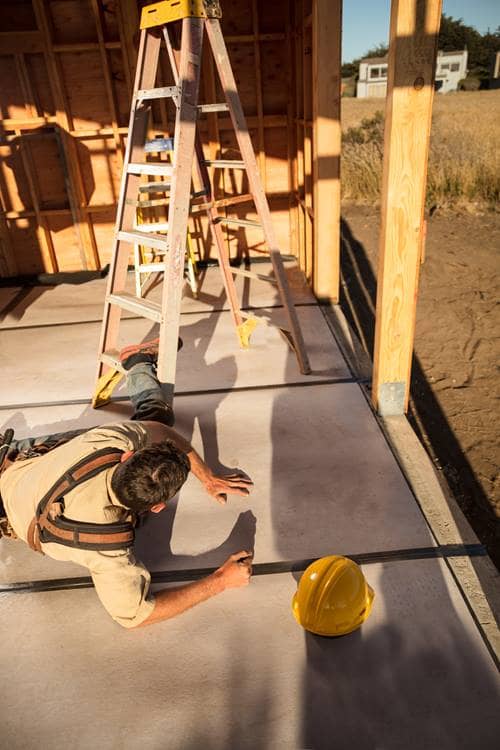Lessons from losses – Young worker falls from ladder

A teenaged retail hardware sales associate was killed when he fell from a fiberglass extension ladder as he tried to change a light bulb. He died of a skull fracture when he landed headfirst on the concrete floor.
The department manager had tried to change the bulb from the ladder by positioning it against a wooden beam near the hanging fixture. When he was unable to complete the job, he indicated he would change it using a forklift after the store closed.
When the manager and his assistant left the area, they expected the victim to put the ladder away and go about his work, but the youth decided to try the job himself. The manager heard the victim shout he had loosened the bulb and turned to see him shaking one arm as if he had been shocked, then waving both arms as he lost his balance and fell to the floor. It appeared he had climbed to the top of the ladder and extended his body over a wooden rafter and was laying across an iron sprinkler pipe to get both hands on the fixture. The 280-volt light fixture was still energized when he touched it.
Later investigation showed the sprinkler pipe may have served as an electrical ground connection, although autopsy results showed no sign of burns or electrical contact.
The employer had a safe work practices component in its general orientation program, but changing light bulbs was not part of the training. The company did not have a written policy specifying who was responsible for changing bulbs and how they were to be changed.
Recommendations by investigators included providing an approved aerial platform and related safety gear; de-energizing the fixture before any work is undertaken, and providing all the necessary tools, including work lights, electrical testing equipment, and any specialized tools for de-energizing or loosening the bulb.
Training tip: ladder placement and use
Ladders are common tools that can be helpful in many types of jobs. Serious injuries can result when a ladder is used improperly, in an unsafe area, or if it is faulty and has not been properly maintained. In addition to knowing how to select and inspect a ladder, the rules for safe ladder setup are also important.
Placement
Before placement, clear the area around the base of the ladder. The feet of the ladder should have slip-resistant safety footing for use on a ground surface that is level and solid. If the ground is too soft, a solid and sufficiently wide support should be placed under each leg. Set up a ladder only on a surface that is level and capable of supporting the weight. Do not set ladders on scaffolds, boxes, or other objects.
Protect ladders near doorways, walkways, or vehicle traffic areas by locking doors, posting signs, setting up barricades, roping off the area, or setting out warning cones.
In many situations, a portable ladder should be tied, blocked, held, or otherwise secured against movement or slippage.
When using a ladder to climb onto a higher surface level, be sure the ladder extends at least 36 inches (three rungs) above that surface level. This provides a handhold for getting on and off the ladder. It also provides a step that is below the ladder’s fulcrum point (the spot the ladder is resting against). Use this step so the ladder does not “kick out” when weight is put on it.
The top of a non-self-supporting ladder must rest against a strong stable surface. Set up non-self-supporting ladders at a height-to-base ratio of 4 to 1. The vertical distance (X) from the top support point to the base of the ladder should be four times the horizontal distance (X/4) from the foot of the ladder to the base of the structure. A simple way to achieve this ratio is to place your feet at base of the ladder and extend your arms. If fingers or palms rest on the rung of the ladder, then the ladder is close to ratio of 4 to 1. If the angle of the ladder is too small, it may fall backwards. If the angle is too great, the legs may slip out or the ladder may break.
The sections of an extension ladder must adequately overlap. Avoid tripping hazards by keeping the area around the tip and base of the ladder clear. Do not run hoses or extension cords along the ladder’s rungs where they will create a tripping hazard.
Source: SafetyNow, SafeSupervisor, November 2022 newsletter

This "document” is intended for general information purposes and should not be construed as advice or opinions on any specific facts or circumstances. The content of this document is made available on an “as is” basis, without warranty of any kind. This document cannot be assumed to contain every acceptable safety and compliance procedure or that additional procedures might not be appropriate under the circumstances. Markel does not guarantee that this information is or can be relied on for compliance with any law or regulation, assurance against preventable losses, or freedom from legal liability. This publication is not intended to be legal, underwriting, or any other type of professional or technical advice. Persons requiring advice should consult an independent adviser or trained professional. Markel does not guarantee any particular outcome and makes no commitment to update any information herein, or remove any items that are no longer accurate or complete. Furthermore, Markel does not assume any liability to any person or organization for loss or damage caused by or resulting from any reliance placed on this content.
Markel® is a registered trademark of Markel Group Inc.
© 2023 Markel Service, Incorporated. All rights reserved.
Tags
